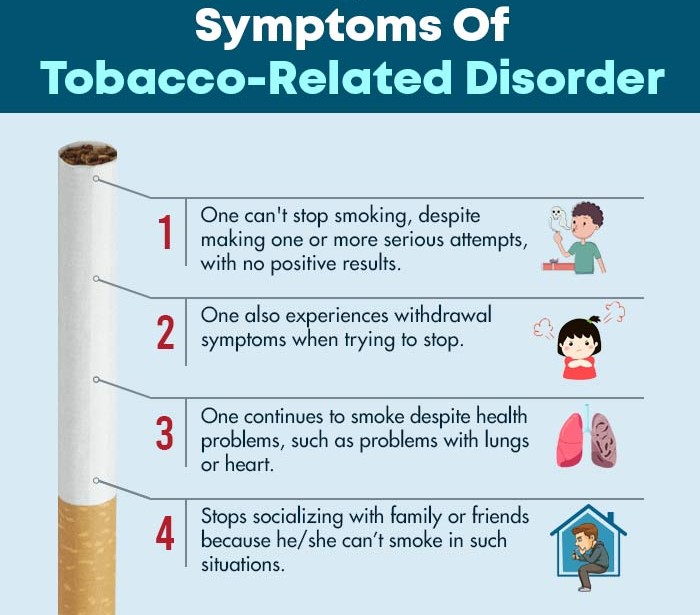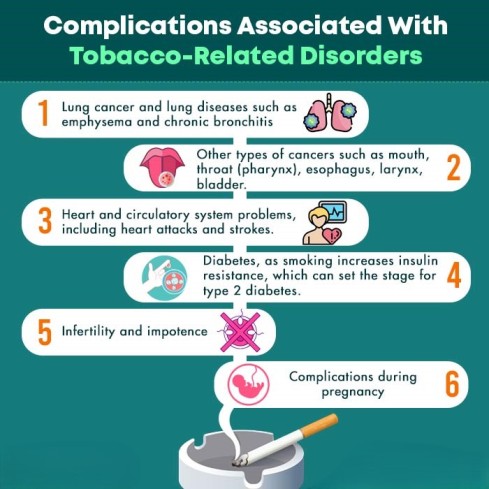The tobacco-related disorder is a condition whereby misuse of tobacco substances results in extreme dependence on nicotine, a substance found in tobacco. Nicotine is the chemical in tobacco that makes it hard to quit and delivers a temporary pleasing effect in the brain. When a person tries to quit tobacco consumption, he/she feels unpleasant, both mentally and physically.
What Are Tobacco-Related Disorders?
Tobacco-related disorders 1 Shahab, L., & Fidler, J. (2012). Tobacco-related disorders. In P. Sturmey & M. Hersen (Eds.), Handbook of evidence-based practice in clinical psychology, Vol. 2. Adult disorders (pp. 167–195). John Wiley & Sons Inc. https://doi.org/10.1002/9781118156391.ebcp002008 , also known as tobacco use disorder 2 Camenga, D. R., & Klein, J. D. (2016). Tobacco Use Disorders. Child and adolescent psychiatric clinics of North America, 25(3), 445–460. https://doi.org/10.1016/j.chc.2016.02.003 , is a condition defined as the misuse of tobacco substances and where the individuals are heavily dependent on nicotine, which is found in tobacco. Nicotine is defined as a psychoactive drug that affects and a stimulant for the central nervous system. The addictive nature of nicotine combines drug-reinforced behavior, obsessive use, and recurrent use even after refraining from using the same.
Tobacco-related disorders are prevalent among individuals who smoke cigarettes and consume tobacco daily, while it is less common among individuals who do not use tobacco daily or who use nicotine medications. The severity of the disorder depends on the amount of tobacco consumption, which ranges from mild, moderate, or severe, depending on the number of diagnostic criteria that have been met. People with this condition continue to use tobacco even though they know it is harmful. Exposure to tobacco smoke can also cause early death in nonsmokers.
It must be noted that all habitual smokers do not qualify for a diagnosis of tobacco-related disorders. Just as there are “social drinkers,” there are “social smokers.” However, since nicotine in tobacco is a highly addictive element, true social smokers are rare. Additionally, tobacco withdrawal may occur in a person who suddenly discontinues or significantly reduces tobacco use after using it on a daily basis for at least several weeks.
The withdrawal symptoms usually last 2-3 weeks which include depression, difficulty in sleeping, impatience, frustration, anger, anxiety, lack of concentrating, slowed heart rate, dry cough, and increased appetite or weight gain. To summarise, we may state that-
- Tobacco-related disorders are a group of behavioural, cognitive, and physical features that arise in people who smoke or use tobacco in other ways on a regular basis.
- Nicotine is an active ingredient in tobacco that triggers dopamine release and leads to the pleasurable effects of smoking. Tolerance and physical dependency develop as a result of chronic nicotine consumption.
- Tobacco withdrawal results in various symptoms and to cope with the same, individuals again go back to the consumption of tobacco.
Prevalence Of Tobacco-Related Disorders
According to a study 3 Paik, S. H., Yeo, C. D., Jeong, J. E., Kim, J. S., Lee, S. H., Kim, S. J., & Kim, D. J. (2019). Prevalence and analysis of tobacco use disorder in patients diagnosed with lung cancer. PloS one, 14(9), e0220127. https://doi.org/10.1371/journal.pone.0220127 , the prevalence of DSM-5 tobacco use disorder was 92.0%. Of 200 subjects, 23 (11.5%), 35 (17.5%), and 126 (63.0%) were classified as mild, moderate, and severe TUD or tobacco-related disorders respectively. A total of 157 (78.5%) subjects showed DSM-IV nicotine dependence, and 141 (70.5%) revealed nicotine dependence physiologically (withdrawal or tolerance).
As per another study of 2003, 4 Rani, M., Bonu, S., Jha, P., Nguyen, S. N., & Jamjoum, L. (2003). Tobacco use in India: Prevalence and predictors of smoking and chewing in a national cross sectional household survey. Tobacco Control, 12(4), 4e-4. https://doi.org/10.1136/tc.12.4.e4 , in India, 30% of the population (15 years or older), 47% men and 14% of women either smoked or chewed tobacco. This prevalence rate, when converted, shows that nearly 195 million people (154 million men and 41million women) in India were into the consumption of tobacco. However, the prevalence of chewing tobacco among men and women may have been underestimated by about 11 % and 1.5 %, respectively, and smoking among males by 5 % and 0.5 %. and women, respectively.
It was also revealed that tobacco consumption was notably common among the poor, less educated, scheduled castes, and scheduled tribe populations. The prevalence of tobacco consumption had grown up to the age of 50 years and then leveled or declined. The prevalence of smoking and chewing also varied extensively between different states and had a strong association with an individual’s socio-cultural characteristics.
A study of 2017 5 Ziedonis, D., Das, S., & Larkin, C. (2017). Tobacco use disorder and treatment: new challenges and opportunities. Dialogues in clinical neuroscience, 19(3), 271–280. https://doi.org/10.31887/DCNS.2017.19.3/dziedonis , between 2010 and 2013, lifetime use of e-cigarettes among US adults had increased notably from 3.3% to 8.5%. The rate of lifetime use of tobacco among cigarette smokers was as high as 36.5% in 2013, whereas only 1.3% of nonsmokers report having tried e-cigarettes. Sixty percent of then-current smokers had reported lifetime use of e-cigarettes, and half report regular use. The study had also revealed that tobacco use is the cause of over 5 million deaths per year globally, which is way more than twice as many deaths due to alcohol and illicit drugs combined.
Causes Of Tobacco-Related Disorders
There are several causes that are assumed to be responsible for triggering tobacco-related disorder or tobacco use disorder. These are as follows.
1. Genetic Factors
Genes contribute to the onset of tobacco use, continued use of tobacco use, and eventually, leading to tobacco-related disorders. Several regions across the genome have been linked to tobacco use disorder, as well as with smoking cessation and treatment.
As per a study 6 Mackillop, J., Obasi, E., Amlung, M. T., McGeary, J. E., & Knopik, V. S. (2010). The Role of Genetics in Nicotine Dependence: Mapping the Pathways from Genome to Syndrome. Current cardiovascular risk reports, 4(6), 446–453. https://doi.org/10.1007/s12170-010-0132-6 , there are numerous quantitative genetic studies that have demonstrated a strong genetic contribution to a variety of features of smoking behaviour and nicotine addiction. The genetic contribution is both population and time-specific and can be defined as the proportion of the cumulative phenotypic variance that is due to genetic effects.
Additionally, the heritability of the clinical phenotype of nicotine dependence remains consistent (~50%) across multiple studies, assessment measures, and cultures as does the heritability of volumetric tobacco consumption is also estimated at about 50%. The study also states that the heritability of smoking initiation was 39% for men and 55% for women, whereas the heritability of smoking persistence was 59% for men and 46% for women.
2. Chemical And Biological Factors
Smoking also increases the levels of dopamine (a type of brain chemical) which further heightens the feelings of pleasure and strengthens the desire to continue smoking. The mood-altering effects of nicotine (pleasure, alertness, relaxation) are powerful and when a person begins to smoke, particularly at a young age, the risk of developing nicotine addiction is high. As per a study 7 Herman, A. I., DeVito, E. E., Jensen, K. P., & Sofuoglu, M. (2014). Pharmacogenetics of nicotine addiction: role of dopamine. Pharmacogenomics, 15(2), 221–234. https://doi.org/10.2217/pgs.13.246 , ”nicotine, the main addictive chemical in tobacco smoke, is essential to continue and compulsive tobacco use”.
3. Medical Factors
People with mental disorders are more prone to smoking than compared to the general population. This includes bipolar disorder, major depressive disorder, anxiety disorders, and schizophrenia.
As per a study 8 Kutlu, M. G., Parikh, V., & Gould, T. J. (2015). Nicotine Addiction and Psychiatric Disorders. International review of neurobiology, 124, 171–208. https://doi.org/10.1016/bs.irn.2015.08.004 , nicotine dependence shows high comorbidity in regards to various mental illnesses including, attention deficit hyperactivity disorder (ADHD), anxiety disorders, and depression. The reason for the high rates of smoking among people with mental illnesses may relate to efforts to self-medicate with nicotine. While nicotine may relieve the symptoms of mental disorders, nicotine abstinence has resulted in worsening the symptoms of such disorders.
For example, 42% of males with ADHD were smokers and 38% of females with ADHD were smokers in comparison to 28.1% and 23.5% male and female smokers respectively without ADHD. The study also reveals that lifetime tobacco dependence was 40% in individuals with ADHD compared to 19%. Additionally, smoking rates were significantly higher in the population with anxiety disorders than it is in the non-clinical population, which is 45.3% and 22.5%, respectively. On the other hand, anxiety disorders are significantly more prevalent in the people diagnosed with nicotine dependence (22%) than in the non-dependent population (11.1%).
Yet another study 9 Nizami, S., Sobani, Z. A., Raza, E., Baloch, N., & Khan, J. (2011). Causes of smoking in Pakistan: an analysis of social factors. AKU Institutional Repository. https://ecommons.aku.edu/cgi/viewcontent.cgi?article=1005&context=pakistan_fhs_mc_med_pulm_critcare states that many causes have been connected to the prevalence and acceptance of smoking in Pakistan. These mainly cater to peer pressure, social requirements, to relieve anxiety, stress, anger, and frustration, along with the addictive nature of nicotine in cigarettes. Additionally, borrowing cigarettes from friends has also been reported among 50% of adolescent smokers, thus implying that easy availability may also play a causal role in smoking.
Symptoms Of Tobacco-Related Disorder

For some people, using any amount of tobacco can quickly lead to nicotine dependence. The following are signs that you may be addicted:
- One can’t stop smoking, despite making one or more serious attempts, with no positive results.
- One also experiences withdrawal symptoms when trying to stop. It essentially means that upon making attempts to stop, one experiences physical and mood-related symptoms, such as anxiety, strong cravings, irritability, lack of concentration, restlessness, depressed mood, rage, frustration, increased hunger, insomnia, constipation, or diarrhea.
- One continues to smoke despite health problems, such as problems with lungs or heart.
- One gives you social activities, avoids no-smoking zones, or stops socializing with family or friends because he/she can’t smoke in such situations.
Read More About The Psychology Behind Smoking Here
Diagnosis Of Tobacco-Related Disorders
To diagnose 10 Baker, T. B., Breslau, N., Covey, L., & Shiffman, S. (2012). DSM criteria for tobacco use disorder and tobacco withdrawal: a critique and proposed revisions for DSM-5. Addiction (Abingdon, England), 107(2), 263–275. https://doi.org/10.1111/j.1360-0443.2011.03657.x a person with tobacco-related disorders, the doctor may ask the patient a few questions or give a questionnaire to fill out to evaluate the person’s dependence on nicotine. This way, the doctor will be able to understand a person’s degree of dependence, thus determining the right treatment plan for the patient. However, to get diagnosed with tobacco-related disorders, he/she must meet the criteria as per the Diagnostic and Statistical Manual of Mental Disorders (DSM-5).
DSM-5 defined this condition as a problematic pattern of tobacco, resulting in clinically significant damage or distress, as demonstrated by at least two of the following, occurring within a 12-month period.
- Tobacco is frequently consumed in larger quantities or over a longer period than was intended.
- There is a constant desire or unsuccessful efforts to cut down or control tobacco use.
- An extensive amount of time is spent on activities required to obtain tobacco or use tobacco.
- Craving, or a strong desire or urge to utilize tobacco.
- Recurrent use of the drug, resulting in a failure to achieve major role responsibilities at work, school, or home.
- Continued use of tobacco despite having persistent social or interpersonal problems caused or increased by the effects of tobacco.
- Tobacco usage causes a reduction or cessation of major social, occupational, or leisure activities.
- Chronic use of tobacco in situations in which it is physically hazardous.
- Continued use of tobacco despite having a persistent physical or psychological problem that is likely to have been caused or exacerbated by tobacco.
- Tolerance, as defined by either of the following.
- A need for considerably increased amounts of tobacco to achieve the desired effect.
- With continued usage of the same amount of tobacco, the impact is significantly reduced.
11. Withdrawal, as demonstrated by either of the following.
- The characteristic withdrawal syndrome for tobacco.
- Tobacco (or a similarly related drug such as nicotine) is used to treat or prevent withdrawal symptoms.
Tobacco-related disorders may also include periods of tobacco withdrawal.
Tobacco Withdrawal
To be diagnosed with tobacco withdrawal, according to the Diagnostic and Statistical Manual of Mental Disorders (DSM-5), one must meet the following criteria.
A. Daily use of tobacco for at least several weeks.
B. Abrupt end of tobacco use, or reduction in the amount of tobacco used, followed by four (or more) of the following symptoms within 24 hours.
- Irritability, frustration, or anger
- Depressed mood
- Difficulty concentrating
- Anxiety
- Increased appetite
- Insomnia
C. The signs or symptoms in Criterion B cause clinically notable distress or hamper social, occupational, or other important areas of functioning.
D. The indications or symptoms are not caused by any physical illness and cannot be explained by another mental problem, such as intoxication or withdrawal from another substance.
Read More About Insomnia Here
Treatment Of Tobacco-Related Disorders
There are effective treatments for tobacco-related disorders or tobacco use disorders. Even though it is a rare thing to treat this disorder, medication, and counselling both have shown effective results.
1. Medications
There are medicines that can help with the treatment of tobacco-related disorders. The usage of non-nicotine medications along with other therapies has proven to work towards reducing the symptoms. It is important to consult a doctor before taking any over-the-counter nicotine replacement products, especially, if the person is pregnant, breastfeeding, smoking fewer than 10 cigarettes a day, or under the age of 18.
2. Nicotine Replacement Therapy
Nicotine replacement therapy 11 Wadgave, U., & Nagesh, L. (2016). Nicotine Replacement Therapy: An Overview. International journal of health sciences, 10(3), 425–435. is designed to provide nicotine without tobacco and the harmful chemicals in tobacco smoke. Nicotine replacement products help ease the cravings for nicotine as well as withdrawal symptoms. The best time to start using nicotine replacement medication is the day when a person stops smoking.
3. Support Groups And Counseling
Along with medications and therapy, behavioral counseling also provides the best chance for establishing long-term smoking abstinence. While medications reduce the withdrawal symptoms including tobacco craving, behavioral treatments help the growth of skills needed to avoid tobacco over the long run.
Some people may also find it helpful to communicate with others who have the same condition as a part of treatment. Individuals find a forum of peer support through self-help groups, gaining strength as they share their thoughts and experiences with others who are going through the same thing they are.
Complications Associated With Tobacco-Related Disorders

Consuming tobacco through smoking or in any other form is known to cause various health issues, cancer being the most common health condition. Even “all-natural” or “herbal” cigarettes contain dangerous substances. People who smoke cigarettes are likely to develop various diseases and die sooner than others who do not smoke. Here are the health complications that come with excess consumption of tobacco.
- Lung cancer and lung diseases such as emphysema and chronic bronchitis
- Other types of cancers such as mouth, throat (pharynx), esophagus, larynx, bladder, pancreas, kidney, cervix, and some types of leukemia
- Heart and circulatory system problems, including heart attacks and strokes
- Diabetes, as smoking increases insulin resistance, which can set the stage for type 2 diabetes.
- Cataracts and macular degeneration are two examples of eye issues.
- Infertility and impotence
- Complications during pregnancy
- Cold, flu, and other illnesses as smokers are prone to respiratory infections, such as colds, the flu, and bronchitis.
- Tooth and gum disease
How To Approach A Loved One?
Approaching your loved one whom you assume to be suffering from tobacco-related disorders is never an easy task as the concerned person may not even consider it to be a condition and may refuse to seek any professional treatment. However, if you feel that your loved one needs professional intervention, consult a professional who is experienced in drug addiction treatment for advice on how to approach the person.
While you cannot force someone to seek treatment, you can support and encourage the person. While it may be a challenge in itself to prevent your loved one from developing the condition, you can still talk to the person about the health-damaging effects of using tobacco and alternatives to using tobacco.
Tobacco-Related Disorders Are Distressing But Manageable
The extensive use of tobacco is becoming the leading cause of death globally. Additionally, consistent use of tobacco by patients with some health disorders may dampen their motivation to quit and reduce their adherence to tobacco cessation interventions. Also, tobacco withdrawal may lead to various, distressing symptoms and to cope with the same, the patients may resume their tobacco consumption.
However, support and encouragement from loved ones along with consistent professional guidance may help reduce the consumption of tobacco to a large extent. Health professionals should focus on behavioral interventions for reducing tobacco use along with the strict introduction of tobacco control measures by the government.
Tobacco-Related Disorder At A Glance
- The tobacco-related disorder is a condition whereby misuse of tobacco substances results in extreme dependence on nicotine, a substance found in tobacco.
- Exposure to tobacco smoke can also cause early death in nonsmokers.
- Some people, using any amount of tobacco can quickly lead to nicotine dependence.
- Consuming tobacco through smoking or in any other form is known to cause various health issues.
- Even though it is a rare thing to treat this disorder, medication, and counselling both have shown effective results.
- The extensive use of tobacco is becoming the leading cause of death globally.















